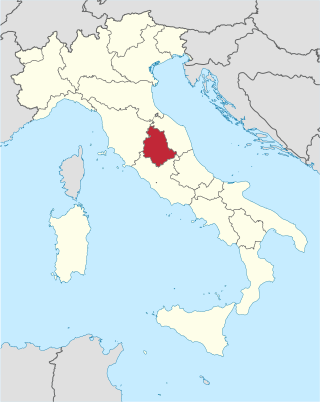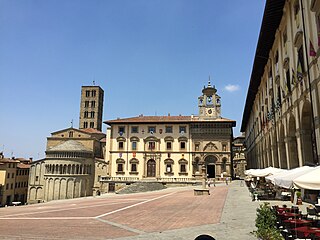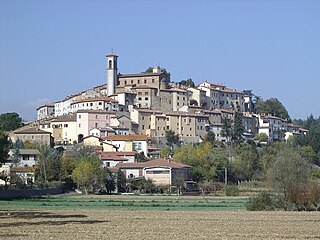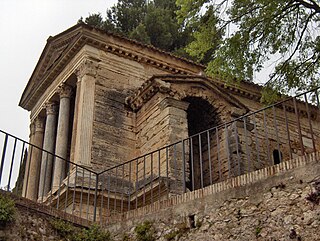
Umbria is a region of central Italy. It includes Lake Trasimeno and Marmore Falls, and is crossed by the Tiber. It is the only landlocked region on the Apennine Peninsula. The regional capital is Perugia.

Arezzo is a city and comune in Italy and the capital of the province of the same name located in Tuscany. Arezzo is about 80 kilometres southeast of Florence at an elevation of 296 metres (971 ft) above sea level. As of 2022, the population was about 97,000.

Stonemasonry or stonecraft is the creation of buildings, structures, and sculpture using stone as the primary material. Stonemasonry is the craft of shaping and arranging stones, often together with mortar and even the ancient lime mortar, to wall or cover formed structures.

San Gimignano is a small walled medieval hill town in the province of Siena, Tuscany, north-central Italy. Known as the Town of Fine Towers, San Gimignano is famous for its medieval architecture, unique in the preservation of about a dozen of its tower houses, which, with its hilltop setting and encircling walls, form "an unforgettable skyline". Within the walls, the well-preserved buildings include notable examples of both Romanesque and Gothic architecture, with outstanding examples of secular buildings as well as churches. The Palazzo Comunale, the Collegiate Church and Church of Sant' Agostino contain frescos, including cycles dating from the 14th and 15th centuries. The "Historic Centre of San Gimignano" is a UNESCO World Heritage Site. The town also is known for saffron, the dry aged and saffron infused Golden Ham, pecorino cheese and its white wine, Vernaccia di San Gimignano, produced from the ancient variety of Vernaccia grape grown on the sandstone hillsides of the area.

Marche, in English sometimes referred to as the Marches, is one of the twenty regions of Italy. The region is located in the central area of the country, and has a population of about 1.5 million people, being the thirteenth largest region in the country by number of inhabitants. The region's capital and largest city is Ancona.

Narni is an ancient hilltown and comune (municipality) of Umbria, in central Italy, with 19,252 inhabitants (2017). At an altitude of 240 metres (790 ft), it overhangs a narrow gorge of the River Nera in the province of Terni. It is very close to the geographical centre of Italy. There is a stone on the exact spot with a sign in multiple languages.

Volterra is a walled mountaintop town in the Tuscany region of Italy. Its history dates from before the 8th century BC and it has substantial structures from the Etruscan, Roman, and Medieval periods.

Norcia, traditionally known in English by its Latin name of Nursia, is a town and comune in the province of Perugia (Italy) in southeastern Umbria. Unlike many ancient towns, it is located in a wide plain abutting the Monti Sibillini, a subrange of the Apennines with some of its highest peaks, near the Sordo River, a small stream that eventually flows into the Nera. The town is popularly associated with the Valnerina. It is a member of I Borghi più belli d'Italia.

Fossato di Vico is a town and comune of Umbria in the province of Perugia in Italy, at 581 m above sea‑level on the middle slopes of Mount Mutali.

Nocera Umbra is a town and comune in the province of Perugia, Italy, 15 kilometers north of Foligno, at an altitude of 520 m above sea-level. The comune, covering an area of 157.19 km2, is one of the largest in Umbria. It is one of I Borghi più belli d'Italia.

Amelia is a town and comune located in central Italy which is part of the province of Terni. The city is located in Umbria not far from the border with Lazio.

Montecatini Val di Cecina is a small hilltown and comune in the province of Pisa in Tuscany. Located approximately 60 kilometres south of Pisa, the medieval town sits on the Poggio la Croce hill overlooking the Cecina Valley and the larger hilltown of Volterra, which lies just 15 km away.

San Miniato is a town and comune in the province of Pisa, in the region of Tuscany, Italy.

Monterchi is a Comune (Municipality) in the Province of Arezzo in the Italian region of Tuscany, located about 80 kilometres (50 mi) southeast of Florence and about 20 kilometres (12 mi) east of Arezzo. It sits in the northern part of Valtiberina, the valley where the Tiber river runs going from Emilia-Romagna towards Rome. The valley runs through Romagna, Tuscany and Umbria, parallel to the Casentino Valley.

A hill town is a type of a settlement built upon hills. Often protected by defensive walls, steep embankments, or cliffs, such hilltop settlements provided natural defenses for their inhabitants. The term "hill town" is occasionally a bit of misnomer, as some of these settlements are built on "pedestals" other than hills in the strict geographical sense.

The so-called Temple of Clitumnus is a small early medieval church that sits along the banks of the Clitunno river in the town of Pissignano near Campello sul Clitunno, Umbria, Italy. In 2011, it became a UNESCO World Heritage Site as part of a group of seven such sites that mark the presence of Longobards in Italy: Places of Power.

Siena is a city in Tuscany, Italy. It is the capital of the province of Siena. Siena is the 12th largest city in the region by number of inhabitants, with a population of 53,062 as of 2022.

Bergfried is a tall tower that is typically found in castles of the Middle Ages in German-speaking countries and in countries under German influence. Stephen Friar in the Sutton Companion to Castles describes a bergfried as a "free-standing, fighting-tower". Its defensive function is to some extent similar to that of a keep in English or French castles. However, the characteristic difference between a bergfried and a keep is that a bergfried was typically not designed for permanent habitation.
The 1920 Garfagnana earthquake occurred on 7 September in Garfagnana and Lunigiana, both agricultural areas in the Italian Tuscany region. The quake hypocenter was located 14 kilometres (8.7 mi) beneath Villa Collemandina. The maximum felt intensity was rated as X (Extreme) on the Mercalli intensity scale, and 6.6 on the Richter scale. It was one of the most destructive seismic events recorded in the Apenninic region in the twentieth century. Due to good news coverage, availability of official documents on the damage and abundance of recordings from surveillance stations throughout Europe, it was regarded as a first-rate case study to improve knowledge of tectonics and macroseismic analysis.

The architecture of Scotland in the Middle Ages includes all building within the modern borders of Scotland, between the departure of the Romans from Northern Britain in the early fifth century and the adoption of the Renaissance in the early sixteenth century, and includes vernacular, ecclesiastical, royal, aristocratic and military constructions. The first surviving houses in Scotland go back 9500 years. There is evidence of different forms of stone and wooden houses exist and earthwork hill forts from the Iron Age. The arrival of the Romans led to the abandonment of many of these forts. After the departure of the Romans in the fifth century, there is evidence of the building of a series of smaller "nucleated" constructions sometimes utilizing major geographical features, as at Dunadd and Dumbarton. In the following centuries new forms of construction emerged throughout Scotland that would come to define the landscape.



















